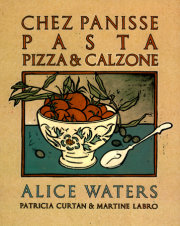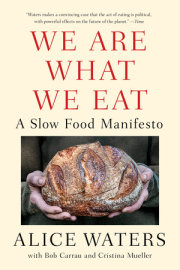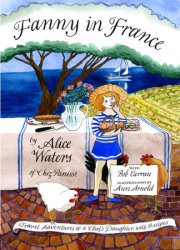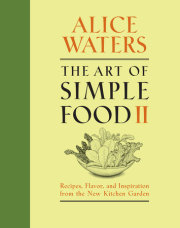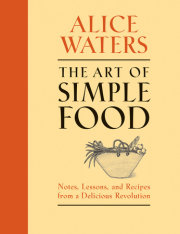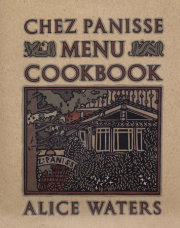Introduction
Why pasta and pizza? To begin with, Chez Panisse has always had strong Mediterranean affinities. We share the same climate and many of the same raw materials. The down-to-earth, lighthearted cuisines of Provence and Italy are a constant source of inspiration – grilled radicchio and anchovies, roasted peppers and garlic, brandade, crusty pizzas baked in wood-burning ovens, mussels and fennel, saffron and tomato fish stews. This is informal food with lively direct flavors. But this cookbook is not a regional, historical, or encylopedic treatment of the subject. It’s meant as an introduction to our style of pasta and pizza: more Provençal than Italian in inspiration, highly personal in execution.
The pasta recipes appear in a seasonal format to show how naturally cooking can reflect the time of year and the kinds of ingredients you might find in a modest kitchen garden. Where pasta is concerned, we generally prefer fresh homemade pasta – thin, delicate, and soft. Pasta is extremely satisfying to make not only because it’s cheap and easy, but because very delicate fresh pasta simply can’t be bought. Our recipes reflect our prejudice for hand processing. Handmade pasta is great to eat and to look at when it has pleasant irregularities: slightly uneven hand-cut noodles look beautiful and taste better, too, because they cook slightly unevenly, resulting in agreeable differences in texture. You can use little metal dies and get absolutely identical, uniform ravioli, but we prefer the looks of larger hand-cut ravioli, with no two exactly alike.
There are also recipes here for dried pasta in a number of different machine-made shapes; our goal has been to match certain sauces and ingredients with the right type and shape of pasta, and for certain dishes – some salads, for example – dried pasta works best.
Pizza has the same immediate appeal as pasta, and it satisfies in the same way. The same principles apply to making it: use a light hand (avoid too much cheese!) and avoid overcomplicated combinations of ingredients. Many of the same combinations of flavors work with both pasta and pizza. Above all, feel free to experiment with many different combinations and variations. Like pasta dough, pizza dough can be flavored in different ways. Try incorporating herbs into the dough – or anchovies or dried tomatoes.
Most of the recipes in this book were directly inspired by the harvest of a small kitchen garden. The picture of our “pasta” garden will give you some idea of the possibilities. If you plant a garden it can change your entire style of cooking. Even a tiny plot with just a few herbs, some salad greens, garlic, leeks, and beans can have a dramatic effect. So much commercial produce is grown for its looks and keeping properties, not for flavor, and there is so much standardization of mass-produced food that we are in danger of forgetting how much variety there can be. Refrigeration, freezing, and packaging technology make it possible for us to eat nothing but the same bland, processed flavors year round. But a small-scale garden can open up a new world of grateful subservience to the seasons. Gardening can become your primary source of culinary inspiration: to be able to go to your back yard, pick something, and make a wonderful, simple, impromptu dish of pasta with it is immensely gratifying. Of course, not everyone can have a garden; but you can befriend people who do, and even some commercial truck farmers and market gardeners attempt to meet the demand for produce grown for quality, not yield.
Our hope is to inspire you rather than direct you. You really need only some conception of the possibilities and a little curiosity. Be receptive to variety and improvisation. We’ve given you some practical pasta and pizza survival techniques along the way, but our main intent is to share our enthusiasm and whimsy.
Flours & Doughs
All-purpose white flour in this country is generally a blend of hard and soft varieties of wheat. Hard and soft refers to the relative gluten content of the wheat, the substance that allows the dough to form a strong and elastic structure. Almost all brands are “enriched” with vitamins and minerals to approximate those contained in the wheat germ, which is not present in white flour. Those labeled “bleached” have been chemically bleached to a uniform whiteness which the manufacturers believe makes a more salable product. This unnecessary process removes some of the flavor and character from the flour.
Whole-wheat flour is milled from the entire wheat berry which includes the wheat germ (with its vitamins, minerals, proteins, and oils) and bran, the fibrous layer surrounding the germ and wheat berry.
Semolina flour is made from very hard or high-gluten wheat, usually durum wheat, which is a hard yellow variety. Generally not ground as fine as our white flours, it has a slightly granular texture. Because of its high gluten content, it makes a strong, fast-drying pasta most suitable for commercial production.
Buckwheat is not a variety of wheat at all, but a weed related to rhubarb. The plant produces bunches of white flowers, the seeds of which are ground to make buckwheat flour. It is nutritious and very flavorful, but since it contains no gluten, it must be blended with wheat flour to make any sort of dough.
Very different pasta doughs can be made from these flours, singly or in combination. The basic dough, made with all-purpose flour and rolled very thin, is fine textured, very delicate, and light. It is particularly well suited to cream sauces, and makes excellent ravioli and lasagne. Pasta made with a combination of white flour and whole-wheat flour has a nutty, breadlike flavor and an interesting texture, because of the fiber content of the bran and wheat germ in the whole grain. Dough made with semolina and white flour has a toothy resilient character that is great when made into slightly thick linguine, and for pasta dishes requiring a noodle with real body. Buckwheat pasta is tender and earthy with a deep, maltlike flavor; it is beautiful in short, wide, hand-cut strips that suit its peasant flavor.
The quality of the flour is an important consideration in making good pasta, but what is often overlooked is the quality of the eggs. The difference between a dough made with a regular market egg and one from a homegrown chicken is dramatic. Chickens that are well fed and allowed to run and scratch, and not fed steroids and antibiotics, produce remarkable eggs. The yolks are intensely yellow and flavorful, and the texture, especially of the whites, is firm and gelatinous and quite unlike the weak, watery, mass-produced egg. They make golden, silky, tasty noodles. Seek out the best source you can find for fresh, real eggs. They will make an incredible difference in your pasta.
The pasta doughs in these recipes were made by hand and rolled with a hand-cranked pasta machine: the kind that clamps onto a work surface, has adjustable settings for the rollers, and various cutting attachments. Rolling the dough is very straightforward, but there are some tricks that are helpful in problem situations.
First, use your hands to mold the dough to an evenly flat, rectangular shape that will be easy for the machine to accept. Put it through the various settings and avoid flouring the dough. If it is properly firm – that is, not too moist – it won’t require flour. If it is a little soft, use a minimum of flour and cut the dough into shorter lengths about midway through the rolling. These are easier to control than one long piece that will fold over on itself and stick together. To prevent the pasta from folding over on itself at the sides as it goes through the rollers, use your free hand to hold the strip of dough back a little and provide tension.
Individual machines vary quite a bit at the last setting, number 6 or 7, depending on the type. Some will roll the pasta too thin and even tear it at that setting, and yet at the next-to-the-last setting, the dough may not be quite as thin as you want it. A solution is to roll the pasta several times through the next-to-last setting, which will make the dough a little thinner each time through, until it has the desired thickness. This also applies to a machine whose final setting does not roll the pasta thin enough. Keep putting the dough through until it is the way you want it.
When you have rolled the pasta to the desired thickness, flour it lightly before putting it through the cutter. This will prevent the pasta from sticking together as it comes out of the cutter, and when you cut the lengths with a knife. Short lengths are much more manageable than long ones, especially when mixing the pasta with the sauce and other ingredients, and they make attractive servings on the plate. Toss the cut noodles well to separate them, let them air dry a few minutes on the table, and then refrigerate. They will stay soft and fresh in the refrigerator several hours before beginning to dry.
Copyright © 2011 by Alice L. Waters; Patricia Curtan & Martine Labro. All rights reserved. No part of this excerpt may be reproduced or reprinted without permission in writing from the publisher.


